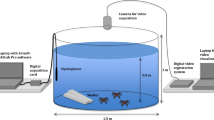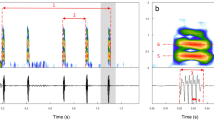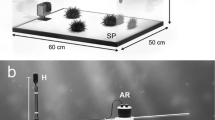Abstract
Despite growing evidence that crustaceans produce and detect sounds, the behavioural and biological function of these sounds is still poorly understood. Here, we describe sounds produced by the New Zealand paddle crab, Ovalipes catharus, and provide evidence of intraspecific communication using underwater sound. Acoustic and video analyses of tank-based experiments show that O. catharus produce at least three distinct sounds: the rasp, zip and bass. Notably, two of these sounds, the zip and bass, were directly correlated with post-copulatory mate-guarding and courtship behaviour and produced only by competing adult male crabs in the presence of a receptive female. Rasp sounds were produced by both sexes; the occurrence significantly increased in the presence of food, and play-back experiments of these sounds initiated a foraging-like behaviour. Responses to rasps might have evolved as a result of acoustic spying. Further, we show that both the rasp and bass sounds were produced by an alternative mechanism than stridulation of the chela ridges. This refutes widespread assumptions that Ovalipes crabs use only stridulation of ridges along their chelae to produce rasp-like sounds. Our results suggest that sound production in decapod crustaceans may be more widespread than previously presumed.










Similar content being viewed by others
References
Akamatsu T, Okumura T, Novarini N, Yan HY (2002) Empirical refinements applicable to the recording of fish sounds in small tanks. J Acoust Soc Am 112(6):3073–3082. https://doi.org/10.1121/1.1515799
Bilodeau AL, Felder DL, Neigel JE (2005) Multiple paternity in the thalassinidean ghost shrimp, Callichirus islagrande (Crustacea: Decapoda: Callianassidae). Mar Biol 146(2):381–385. https://doi.org/10.1007/s00227-004-1444-1
Breithaupt T, Tautz J (1990) The sensitivity of crayfish mechanoreceptors to hydrodynamic and acoustic stimuli. In: Wiese K, Krenz WD, Tautz J, Reichert H, Mulloney B (eds) Frontiers in crustacean neurobiology. Advances in life sciences. Birkhäuser, Basel. pp 114–120. https://doi.org/10.1007/978-3-0348-5689-8_12
Brockerhoff A, McLay C (2005) Mating behaviour, female receptivity and male–male competition in the intertidal crab Hemigrapsus sexdentatus (Brachyura: Grapsidae). Mar Ecol Prog Ser 290:179–191. https://doi.org/10.3354/meps290179
Budelmann BU (1992) Hearing in Crustacea. In: Webster DB, Popper AN, Fay RR (eds) The evolutionary biology of hearing. Springer, New York, pp 131–139. https://doi.org/10.1007/978-1-4612-2784-7_9
Buscaino G, Gavio A, Galvan D, Filiciotto F, Maccarrone V, de Vincenzi G, Mazzola S, Orensanz JM (2015) Acoustic signals and behaviour of Ovalipes trimaculatus in the context of reproduction. Aquat Biol 24:61–73. https://doi.org/10.3354/ab00636
Candolin U (2007) The use of multiple cues in mate choice. Biol Rev 78(4):575–595. https://doi.org/10.1017/S1464793103006158
Clayton D (2008) Singing and dancing in the ghost crab Ocypode platytarsus (Crustacea, Decapoda, Ocypodidae). J Nat Hist 42(3–4):141–155. https://doi.org/10.1080/00222930701840530
Crane J (1966) Combat, display and ritualization in fiddler crabs (Ocypodidae, genus Uca). Philos T R Soc B, Biol Sci 251(772):459–472. https://doi.org/10.1098/rstb.1966.0035
Duffy JE, Thiel M (2007) Sexual and Social Behavior of Crustacea—a Way Forward. In: Duffy JE, Thiel M (eds) Evolutionary ecology of social and sexual systems: crustaceans as model organisms. Oxford University Press on Demand, New York, pp 461–474. https://doi.org/10.1093/acprof:oso/9780195179927.001.0001
Elias DO, Mason AC, Maddison WP, Hoy RR (2003) Seismic signals in a courting male jumping spider (Araneae: Salticidae). J Exp Biol 206:4029–4039. https://doi.org/10.1242/jeb.00634
Favaro L, Tirelli T, Gamba M, Pessani D (2011) Sound production in the red swamp crayfish Procambarus clarkii (Decapoda: Cambaridae). Zoo Anz 250(2):143–150. https://doi.org/10.1016/j.jcz.2011.01.002
Gerhardt HC, Huber F (2002) Acoustic communication in insects and anurans: common problems and diverse solutions. University of Chicago Press, Chicago, pp 1–509
Gleeson RA (1991) Intrinsic factors mediating pheromone communication in the blue crab, Callinectes sapidus. In: Bauer RT, Martin JW (eds) Crustacean sexual biology. Columbia, New York Chichester, West Sussex. pp 17–32. https://doi.org/10.7312/baue90796-003
Goeritz ML, Flood AS, Radford CA (2018) Sound production in decapod crustaceans: Behavioral contexts and a newly found role for the circuits of the stomatogastric nervous system. In: International congress of neuroethology 2018 Brisbane, Australia. International Society for Neuroethology, pp 31–32
Guinot-Dumortier D, Dumortier B (1960) La stridulation chez les crabes. Crustaceana 1(2):117–155
Haddon M (1994) Size-fecundity relationships, mating behaviour, and larval release in the New Zealand paddle crab, Ovalipes catharus (White 1843) (Brachyura: Portunidae). New Zeal J Mar Fresh 28(4):329–334. https://doi.org/10.1080/00288330.1994.9516622
Halfwerk W, Varkevisser J, Simon R, Mendoza M, Scharff C, Riebel K (2019) Toward testing for multimodal perception of mating signals. Front Ecol Evol 7:124. https://doi.org/10.3389/fevo.2019.00124
Hebets EA, Papaj DR (2005) Complex signal function: developing a framework of testable hypotheses. Behav Ecol Sociobiol 57(3):197–214. https://doi.org/10.1007/s00265-004-0865-7
Hebets EA, Rundus A (2010) Chemical communication in a multimodal context. In: Breithaupt T, Thiel M (eds) Chemical communication in crustaceans. Springer, New York, pp 335–354. https://doi.org/10.1007/978-0-387-77101-4_17
Hebets EA, Barron AB, Balakrishnan CN, Hauber ME, Mason PH, Hoke KL (2016) A systems approach to animal communication. Proc R Soc London, Ser 283(1826):20152889. https://doi.org/10.1098/rspb.2015.2889
Heinzel HG (1988) Gastric mill activity in the lobster. I. Spontaneous modes of chewing. J Neurophysiol 59(2):528–550. https://doi.org/10.1152/jn.1988.59.2.528
Horch K (1971) An organ for hearing and vibration sense in the ghost crab Ocypode. Vergl Physiol 73(1):1–21. https://doi.org/10.1007/BF00297698
Horch K (1975) The acoustic behavior of the ghost crab Ocypode cordimana Latreille, 1818 (Decapoda, Brachyura). Crustaceana 29(2):193–205
Jivoff P, Hines AH (1998a) Effect of female molt stage and sex ratio on courtship behavior of the blue crab Callinectes sapidus. Mar Biol 131:533–542. https://doi.org/10.1007/s002270050345
Jivoff P, Hines AH (1998b) Female behaviour, sexual competition and mate guarding in the blue crab, Callinectes sapidus. Anim Behav 55(3):589–603. https://doi.org/10.1006/anbe.1997.0646
Johnson ML, Gaten E, Shelton PM (2002) Spectral sensitivities of five marine decapod crustaceans and a review of spectral sensitivity variation in relation to habitat. J Mar Biol Assoc UK 82(5):835–842. https://doi.org/10.1017/S0025315402006203
Kalmijn AJ (1988) Hydrodynamic and acoustic field detection. In: Atema J, Fay RR, Popper AN, Tavolga WN (eds) Sensory biology of aquatic animals. Springer, New York, pp 83–130. https://doi.org/10.1007/978-1-4612-3714-3_4
Kamio M, Reidenbach MA, Derby CD (2008) To paddle or not: context dependent courtship display by male blue crabs, Callinectes sapidus. J Exp Biol 211:1243–1248. https://doi.org/10.1242/jeb.014977
Madsen PT, Wahlberg M (2007) Recording and quantification of ultrasonic echolocation clicks from free-ranging toothed whales. Deep Sea Res Part I 54(8):1421–1444. https://doi.org/10.1016/j.dsr.2007.04.020
Mazzoni D (2016) AUDACITY 2.1.2. Available from: https://www.audacityteam.org/download/
McLay CL (1988) Crabs of New Zealand. Leigh Marine Laboratory Bulletin. University of Auckland, Auckland
Mensinger AF (2013) Disruptive communication: stealth signaling in the toadfish. J Exp Biol 217(3):344–350. https://doi.org/10.1242/jeb.090316
Myrberg AA (1997) Sound production by a coral reef fish (Pomacentrus partitus): evidence for a vocal, territorial “keep-out” signal. Bull Mar Sci 60:1017–1025
Myrberg AA Jr, Mohler M, Catala JD (1986) Sound production by males of a coral reef fish (Pomacentrus partitus): its significance to females. Anim Behav 34(3):913–923. https://doi.org/10.1016/S0003-3472(86)80077-X
Osborne TA (1987) Life history and population biology of the paddle crab, Ovalipes catharus. Dissertation, University of Canterbury, Christchurch, New Zealand
Parmentier E, Fine ML (2016) Fish sound production: insights. In: Suthers R, Fitch W, Fay R, Popper A (eds) Vertebrate sound production and acoustic communication@ Springer Handbook of Auditory Research, vol 53. Springer, Cham, pp 19–49. https://doi.org/10.1007/978-3-319-27721-9_2
Partan SR, Marler P (2005) Issues in the classification of multimodal communication signals. Am Nat 166(2):231–245. https://doi.org/10.1086/431246
Patek SN, Caldwell RL (2006) The stomatopod rumble: low frequency sound production in Hemisquilla californiensis. Mar Freshw Behav Physiol 39(2):99–111. https://doi.org/10.1080/10236240600563289
Patek SN, Shipp LE, Staaterman ER (2009) The acoustics and acoustic behavior of the California spiny lobster (Panulirus interruptus). J Acoust Soc Am 125(5):3434–3443. https://doi.org/10.1121/1.3097760
Payne R, Webb D (1971) Orientation by means of long range acoustic signalling in baleen whales. Ann NY Acad Sci 188:110–141. https://doi.org/10.1111/j.1749-6632.1971.tb13093.x
Popper A, Salmon M, Horch K (2001) Acoustic detection and communication by decapod crustaceans. J Comp Physiol A 187:83–89. https://doi.org/10.1007/s003590100184
Radford CA, Tay K, Goeritz ML (2016) Hearing in the paddle crab, Ovalipes catharus. Proc Mtgs Acoust 27:010013. https://doi.org/10.1121/2.0000259
Rondeau A, Sainte-Marie B (2001) Variable mate-guarding time and sperm allocation by male snow crabs (Chionoecetes opilio) in response to sexual competition, and their impact on the mating success of females. Biol Bull 201(2):204–217. https://doi.org/10.2307/1543335
Ryan MJ (1990) Sexual selection, sensory systems and sensory exploitation. In: Douglas F, Janis A (eds) Oxford Surveys in Evolutionary Biology, vol 7, pp 157–195
Salmon M (1967) Coastal distribution, display and sound production by Florida fiddler crabs (genus Uca). Animal Behav 15(4):449–459. https://doi.org/10.1016/0003-3472(67)90043-7
Salmon M, Atsaides SP (1968) Visual and acoustical signalling during courtship by fiddler crabs (genus Uca). Am Zool 8:623–639. https://doi.org/10.1093/icb/8.3.623
Salmon M, Horch KW (1972) Acoustic signalling and detection by semiterrestrial crabs of the family Ocypodidae. In: Winn HE, Olla BL (eds) Behavior of marine animals. Springer, Boston, pp 60–96. https://doi.org/10.1007/978-1-4684-0907-9_2
Selverston A, Szücs A, Huerta R, Pinto RD, Reyes MB (2009) Neural mechanisms underlying the generation of the lobster gastric mill motor pattern. Front Neural Circuit 3:12. https://doi.org/10.3389/neuro.04.012.2009
Sneddon LU, Huntingford FA, Taylor AC, Clare AS (2003) Female sex pheromone-mediated effects on behavior and consequences of male competition in the shore crab (Carcinus maenas). J Chem Ecol 29(1):55–70. https://doi.org/10.1023/A:1021972412694
Sørensen PW, Scott AP (1994) The evolution of hormonal sex pheromones in teleost fish: poor correlation between the pattern of steroid release by goldfish and olfactory sensitivity suggests that these cues evolved as a result of chemical spying rather than signal specialization. Acta Physiol Scand 152(2):191–205. https://doi.org/10.1111/j.1748-1716.1994.tb09799.x
Staaterman E, Claverie T, Patek S (2010) Disentangling defense: the function of spiny lobster sounds. Behaviour 147(2):235–248. https://doi.org/10.1163/000579509X12523919243428
Staaterman ER, Clark CW, Gallagher AJ, deVries MS, Claverie T, Patek SN (2011) Rumbling in the benthos: acoustic ecology of the California mantis shrimp Hemisquilla californiensis. Aquat Biol 13(2):97–105. https://doi.org/10.3354/ab00361
Stephenson W (1969) The morphology of stridulatory structures in the genus Ovalipes Rathbun. Trans R Soc New Zealand, Bio Sci 11(4):43–71
van Oosterom L, Montgomery JC, Jeffs AG, Radford CA (2016) Evidence for contact calls in fish: conspecific vocalisations and ambient soundscape influence group cohesion in a nocturnal species. Sci Rep 6:19098. https://doi.org/10.1038/srep19098
Wear RG, Haddon M (1987) Natural diet of the crab Ovalipes catharus (Crustacea, Portunidae) around central and northern New Zealand. Mar Ecol Prog Ser 35(1/2):39–49
Wood DE, Derby CD (1995) Coordination and neuromuscular control of rhythmic behaviors in the blue crab, Callinectes sapidus. J Comp Physiol A 177(3):307–319. https://doi.org/10.1007/BF00192420
Wyatt TD (2010) Pheromones and Behavior. In: Breithaupt T, Thiel M (eds) Chemical communication in crustaceans. Springer, New York, pp 22–38. https://doi.org/10.1007/978-0-387-77101-4_2
Acknowledgements
We would like to thank the staff at the Leigh Marine Laboratory, in particular Errol Murray and Peter Browne for their help building the experimental setup and assistance collecting animals. We would also like to thank Katya Ruggiero for statistical advice and Colin McLay for his expertise. We also thank our two anonymous reviewers and editor Martin Thiel for their valuable input and helpful suggestions.
Author information
Authors and Affiliations
Corresponding author
Ethics declarations
Conflict of interest
The authors declare that they have no conflict of interest.
Ethical approval
All applicable international, national and/or institutional guidelines for sampling, care and experimental use of organisms for the study have been followed and all necessary approvals have been obtained. All procedures involving animals were performed in accordance with the Ethical Standards of the University of Auckland and were approved by the Animal Ethics Committee (AEC), approval number 001721.
Data availability
The data sets generated during and/or analysed during the current study are available from the corresponding author upon reasonable request.
Additional information
Responsible Editor: M. Thiel.
Publisher's Note
Springer Nature remains neutral with regard to jurisdictional claims in published maps and institutional affiliations.
Reviewed by I. Hinojosa and an undisclosed expert.
Electronic supplementary material
Below is the link to the electronic supplementary material.
Rights and permissions
About this article
Cite this article
Flood, A.S., Goeritz, M.L. & Radford, C.A. Sound production and associated behaviours in the New Zealand paddle crab Ovalipes catharus. Mar Biol 166, 162 (2019). https://doi.org/10.1007/s00227-019-3598-x
Received:
Accepted:
Published:
DOI: https://doi.org/10.1007/s00227-019-3598-x




